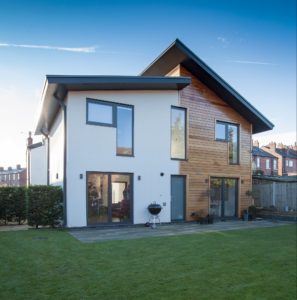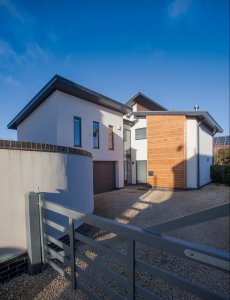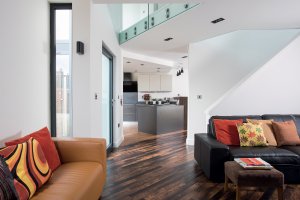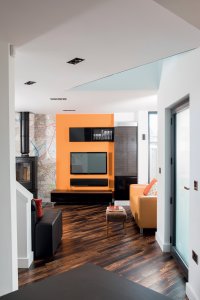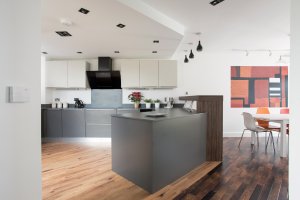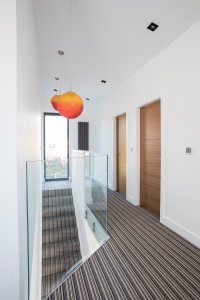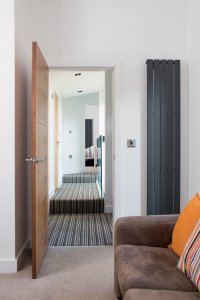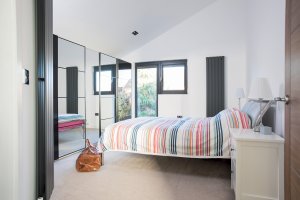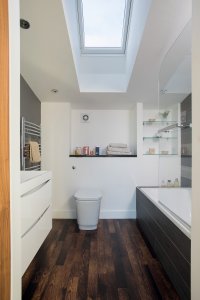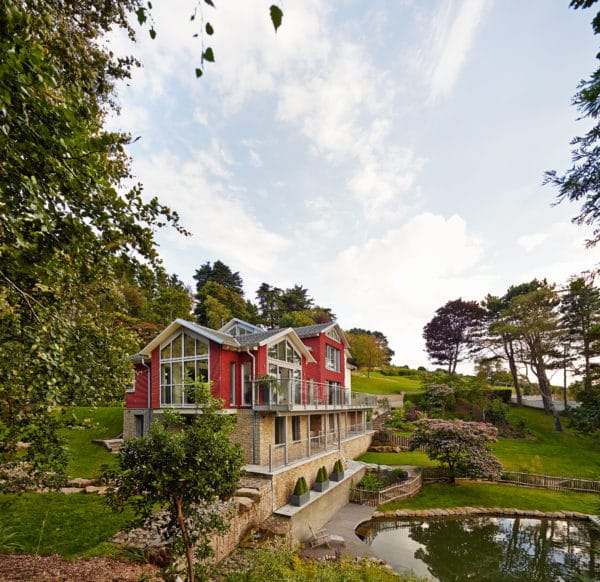Modern Timber Frame Home on a Garden Plot
It took Jonathan Bootland four years and a vow not to be beaten to get planning permission for his contemporary timber frame home at the heart of a suburban housing development.
Despite strong and persistent protests from neighbours, as well as rejection at all planning levels – including committee and appeal – resulting in considerable personal expense, Jonathan was adamant that his idea was worth pursuing.
“Whatever objection you can think of, it was thrown at me,” he says of the scheme to build a four-bedroom family home on the site of a dilapidated outbuilding in his back garden. “The neighbours created a posse, raising funds to employ a planning consultant who submitted an eight-page report to the local authority as to why planning shouldn’t be granted!”
Not giving up, Jonathan continued to modify his plans for the house until there was nothing left to object to. “I think I wore them down,” he says. “I just wasn’t prepared to give in and was adamant that this was going to be the site of our family home.”
Planning problems
Jonathan’s plan was to self-build in the large, overgrown garden of the 19th-century house that he modernised and extended in 2010.
Before then, the property hadn’t been updated since 1949, so he stripped everything out, renovating the shell without losing any of its significant original features. The next stage of the project was the addition of a contemporary three-storey extension to the rear.
- Names Jonathan & Janine Bootland
- LocationWest Yorkshire
- Type of projectSelf-build
- StyleContemporary
- Construction methodTimber frame
- Project routeSelf project-managed
- Plot size367m2
- Land costAlready owned
- House size193m²
- Project cost£212,050
- Project cost per m2£1,099
- Construction time16 months
- Current value £469,000
“Over the years I’ve undertaken several major renovations, but never building from scratch,” he says. “It’s something I’ve always wanted to do since creating my first Lego house as a child. With a property update you take many steps backwards before you move forwards, and there are usually a lot of hidden issues and technical challenges, so I thought a new build would be a very different experience.”
However, he hadn’t realised just how different. “I thought that planning would be straightforward, but we hit a wall before we had even begun,” says Jonathan. “We had no idea it would take so long or that there would be such strong resistance.”
The first application went to appeal and was still rejected, so the Bootlands adapted the house plans to take into account everyone’s concerns and to address all the issues. In the end, after going to committee twice, planning permission was eventually granted.
“That process was by far the hardest part of the build, but I didn’t let it get under my skin,” he says. “I understand that people resist change and not everyone likes modern design, but I wanted to build a family house for the future.”
Design & glazing
Planning had taken so long to achieve that some of the contractors and tradespeople Jonathan had originally wanted to use were by now committed to other long-term projects, but he soon pulled together a new team who could turn the drawings into a reality.
The couple’s dream was to build a light, spacious timber-frame family home for them and their three young children. But Jonathan accepted that he had to make some major compromises due to the objections – particularly when it came to the orientation of glazing, due to the site’s proximity to neighbouring properties.
Jonathan was prevented from having a large picture window at one end of the sitting area, so through innovative design he created two narrow 5m-tall side panels that facilitated both light and privacy. Upstairs, rooflights and floor-to-ceiling windows draw plenty of additional natural brightness across the landing, while an internal bridge landing allows the same light to filter down to the ground floor.
To compensate for the restrictions at the front, Jonathan included banks of glazing across the back. “I have always had a pragmatic mindset when it comes to projects; where there’s a will there’s a way,” he says. “I don’t think it matters whether you spend £100,000 or a million-pounds-plus, there will always be compromises.”
Starting construction
As the project began, more than 250 tonnes of rubble were ferried away, drainage installed and concrete beam-and-block foundations laid. The timber frame was prefabricated, complete with insulation, to save time and ensure a high-quality finished product. This was then transported to the site, with the ground floor completed within a couple of days.
The joists were decked with 22mm CaberShieldPlus chipboard flooring, which has a waterproof coating so that it can stay dry during exposure to the elements during the build.
Once the floor was secured, it allowed for the safe construction of the first-storey walls and monopitched roofs. A Protan roofing membrane was applied the following week to ensure weather protection.
Complementing the hues of the roof covering, the anthracite-coloured aluminium windows (sourced from Express Bi-Folding Doors) were installed to ensure a complete water-resistant shell within weeks.
To complete the roof works, and to make an appealing architectural statement, Jonathan decided to install Marley Alutec soffits and fascias. “They weren’t cheap, but on balance they were the right product to give the aesthetics the roof deserved, while also providing longevity and reducing maintenance,” he says.
The external walls were finished with cedar cladding and render, applied on top of the vapour control layer. The StoRend Flex render was the only finish of this kind certified by the BBA that met with the approval of the NHBC, which was supplying Jonathan’s 10-year warranty. If he had not used this product, NHBC wouldn’t have been willing to issue the protection Jonathan wanted.
Energy efficient
The Bootlands were concerned about achieving a good SAP rating; in particular, they didn’t want to accidentally miss targets for Part G of the Building Regulations, which cover the efficient use of water.
“You don’t get the SAP report until the end of the project, so it’s not difficult to come unstuck if you don’t do your research beforehand. It’s all too easy to put the wrong taps or showers in that don’t meet the correct flow rates,” Jonathan says. “I’d heard of self-builders not having the report completed until the end of the project, only to find out that the products installed were not compliant.”
So he decided to employ independent consultant, Energist, to ensure success. “I forwarded the regs drawings and product details to them for prior approval,” says Jonathan.
Through this, he also discovered that the woodburning stove he was thinking of ditching for financial reasons was actually more affordable than he thought – without it, he would’ve needed to upgrade the insulation in the walls and roof. “Suddenly a woodburner became a pragmatic necessity,” he says.
Jonathan admits that he found the airtightness test a bit nail-biting, and even though he had continually stressed to contractors the importance of keeping everything in the build process as well sealed as possible, he was still relieved to hit the target.
Build budget
Jonathan worked carefully to ensure he got the most out of his budget and future home. “I spent hours researching everything,” he says. “The internet is a valuable tool because you can source the latest products and look for the best prices at the click of a button. I saved tens of thousands of pounds by doing this – although you have to bear in mind that this is offset by the time you invest in doing it.”
The exception was the kitchen, for which Jonathan went to Leeds-based Arlington Interiors. He was impressed by the company’s ability to listen to his brief and design something stunning that didn’t break the bank. “They helped me save money on my appliances through their alliances with suppliers,” he says. “Even my internet trawling couldn’t beat the Siemens prices I was quoted by them!”
Looking back, Jonathan feels that the entire house build was an education process for him in so many ways. “I enjoy researching and I think the hours spent looking for innovative low-cost products over many evenings and weekends really paid off in the end,” he says.
“By putting in the time – both investigating and project managing the build – we came within budget and it all ran like clockwork. We achieved what we set out to do, which was to build a family home that was light, modern, energy efficient and low-maintenance. The result has certainly lived up to all our expectations, and more.”
So he decided to employ independent consultant, Energist, to ensure success. “I forwarded the regs drawings and product details to them for prior approval,” says Jonathan.
Through this, he also discovered that the woodburning stove he was thinking of ditching for financial reasons was actually more affordable than he thought – without it, he would’ve needed to upgrade the insulation in the walls and roof. “Suddenly a woodburner became a pragmatic necessity,” he says.
Jonathan admits that he found the airtightness test a bit nail-biting, and even though he had continually stressed to contractors the importance of keeping everything in the build process as well sealed as possible, he was still relieved to hit the target.
Build budget
Jonathan worked carefully to ensure he got the most out of his budget and future home. “I spent hours researching everything,” he says. “The internet is a valuable tool because you can source the latest products and look for the best prices at the click of a button. I saved tens of thousands of pounds by doing this – although you have to bear in mind that this is offset by the time you invest in doing it.”
The exception was the kitchen, for which Jonathan went to Leeds-based Arlington Interiors. He was impressed by the company’s ability to listen to his brief and design something stunning that didn’t break the bank. “They helped me save money on my appliances through their alliances with suppliers,” he says. “Even my internet trawling couldn’t beat the Siemens prices I was quoted by them!”
Looking back, Jonathan feels that the entire house build was an education process for him in so many ways. “I enjoy researching and I think the hours spent looking for innovative low-cost products over many evenings and weekends really paid off in the end,” he says.
“By putting in the time – both investigating and project managing the build – we came within budget and it all ran like clockwork. We achieved what we set out to do, which was to build a family home that was light, modern, energy efficient and low-maintenance. The result has certainly lived up to all our expectations, and more.”
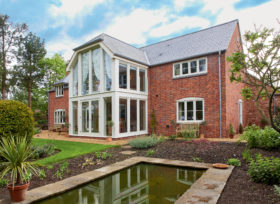
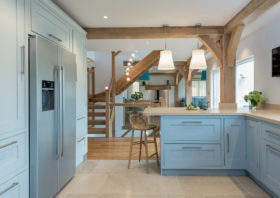






























































































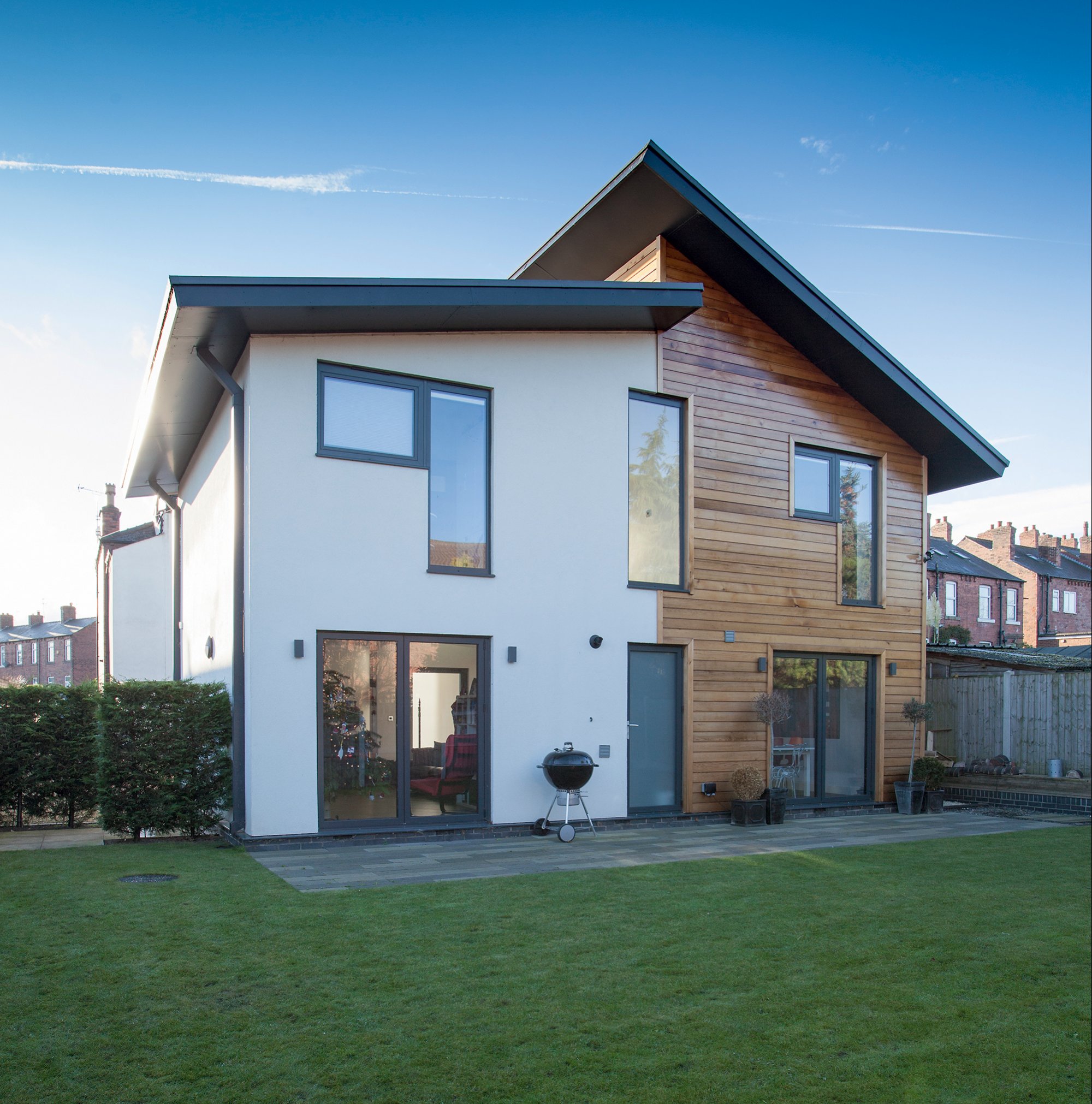
 Login/register to save Article for later
Login/register to save Article for later

